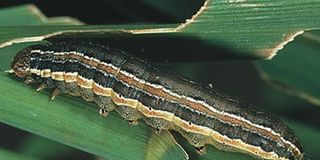Prime
Army worm now turns to vegetables, bananas as government mulls aerial spray

The fall armyworms that have mainly been attacking cereal crops such as maize and sugar cane have now turned to bananas and several vegetables
What you need to know:
- Eighty per cent of the said total exports earnings are agricultural products such as maize, tobacco, tea, hides and skins, cocoa beans, other livestock/dairy, sim sim, flowers, beans, and cotton.
- Other African countries such as Zambia, Zimbabwe, Kenya and Malawi are experiencing the same problem of the worm whose adult moths move in large swarms at night with each female laying up to 2000 eggs and the emerging caterpillars are aggressive feeders with the potential to destroy a hectare within 72 hours in its later stages, according to the Agriculture ministry.
KAMPALA. The fall armyworms that have mainly been attacking cereal crops such as maize and sugar cane have now turned to bananas and several vegetables sending panic among stakeholders on future food security and incomes.
Ministry officials and farmers who spoke to this newspaper yesterday confirmed the invasion of bananas, vegetables, watermelon gardens, among other crops, by the crop-destroying caterpillars despite the ministry procuring and disturbing pesticide Striker 247 SC to contain the pests.
“The pests have also attacked vegetables. I am going for a sectorial meeting to see if we can carry out aerial spray,” State minister for Agriculture Christopher Kibanzanga told this paper by telephone.
Farmers in Luweero, Mubende, Ntugamo and Buikwe districts, have all confirmed the pests on their bananas which Mr Andrew Ssewanyana, a farmer said the pests first attacks the middle leaves making bearing banana impossible.
“The pest attacks the middle part and whatever leaves the banana attempts to bring, they are eaten,” Mr Ssewanyana said adding that they are now using a new black off pesticide to tackle the pests which has shown positive results.
Banana is one of the staple foods in Uganda. Uganda Bureau of Statistics 2015 abstract report indicates that Western Uganda produced 2,883,653 metric tonnes of banana, while the Central region produced 1,039,834 metric tonnes. Central was followed by east with 342,236 metric tonnes, while Northern Uganda produced a paltry 31,626 tonnes.
Exports at risk
Last week, Mr Kibanzanga told this paper that “I believe we can successfully fight this worm,” “But if we do not, it will be a disaster. Countries which import our crops will fear to import our tomatoes, maize, cabbages, beans … thinking our export will carry these pests into their countries,” he said.
Earlier, the ministry had asked for Shs25b from the Finance ministry to fight the worm but so far, Mr Kibanzanga said Shs10b has been received and with that budget, officials should be able to stop the spread of the worm. “Let our officials be creative to cut costs. They should use police, army and district vehicles to reach farmers in remote villages urgently because money can never be enough. Let them also sensitise farmers through our free airtime on radios,” he said last week.
Bank of Uganda and Uganda Bureau of Statistics (Ubos) statistics show that the country in 2011 earned $2.8 billion (Shs10 trillion) worth of exports, this rose to about $3.6 billion (Shs13 trillion) in 2012.
The exports then declined to $3.14 billion (Shs11 trillion) and more seriously went down to $3 billion (Shs10.8 trillion) at the end of 2015.
Eighty per cent of the said total exports earnings are agricultural products such as maize, tobacco, tea, hides and skins, cocoa beans, other livestock/dairy, sim sim, flowers, beans, and cotton.
Uganda produces nearly 4 million metric tons of maize grain annually, making it the third highest crop produced. Maize contributes to the livelihoods of more than 3.6 million households according to Uganda Bureau of Statistics 2014
To control the pest, Mr Okaasai Opolot, the director for Crop Resources in the Ministry of Agriculture, says the only available means now is by spraying the affected gardens with two tested pesticides types; Striker 247 SC and Rockett 44EC.
Striker cost Shs32, 000 and Rockett 44EC not more than Shs20, 000.
He says 20-50mls of the said pesticides should be mixed in 15 – 20 litres of water before spraying. Spraying should be done between 7-8am and 5-7pm when the caterpillar is active and should be done twice a week.
Although government has already distributed more than 2,500 litres of Striker to farmers in badly affected districts across the country, Mr Opolot encouraged farmers to procure their own pesticides and not wait on government. “Government cannot afford to give free pesticides to all farmers. What we procured was for demonstration purposes and to let farmers know which pesticides work. We expect them to buy their pesticides,” Mr Opolot said.
Across Africa
Other African countries such as Zambia, Zimbabwe, Kenya and Malawi are experiencing the same problem of the worm whose adult moths move in large swarms at night with each female laying up to 2000 eggs and the emerging caterpillars are aggressive feeders with the potential to destroy a hectare within 72 hours in its later stages, according to the Agriculture ministry.




